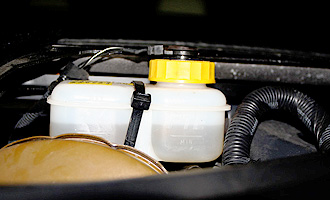| Routine Maintenance | << Back to Education |
Brake Fluid Level
Having your car break down is at best inconvenient, but at worst can be very dangerous.
We have therefore created this section to help you keep your car in road worthy condition and reduce the chances of vehicle malfunction.
To find information about how to act if you do breakdown, click here

Brake Fluid Level
| Early cars require you remove the fluid cap (or caps) in order to inspect the brake fluid level. | |
| Always clean the reservoir cap and the area around it prior to removing it. This helps to prevent dirt and debris from entering the brake fluid master cylinder reservoir. | |
| On later model vehicles, the reservoir is transparent so you can inspect fluid levels without removing the cap. Typically, the reservoir is marked “MINIMUM” and often with “MAXIMUM” as well. | |
| Fluid should not be over the maximum and obviously should not be below the minimum. | |
| If the system is leaking, stop! Do not drive the car any further. You should contact a mechanic as soon as possible to determine the cause. | |
| Before adding fluid, check the owner's manual to determine brake fluid specifications for your particularly vehicle. The use of incorrect fluid can damage the hydraulic system parts within the brake system. | |
| When adding fluid, pour it into the open reservoir slowly. The reasoning here is, you really don't want air bubbles to enter the hydraulic system. | |
| Be very careful with brake fluid. If you spill fluid on the vehicle's finish, paint damage can (and most often will) occur. Wash the fluid off with cold water immediately. |
© ![]() has compiled this information to be used for educational purposes only
has compiled this information to be used for educational purposes only








